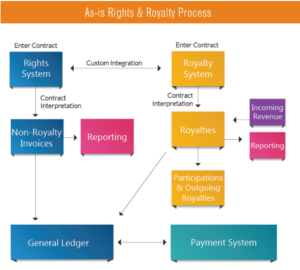Connections

A Single Source of Truth: Rights Management in the Age of Digitalization
Story Highlights
By Michael McGuire, Chief Revenue Officer, FilmTrack–
Over the past decade, the M&E ecosystem has been completely redefined. Advances in technology have completely changed the game, allowing consumers to access content faster and easier than ever before. Likewise, the shift to an on-demand culture has created new opportunities for businesses to leverage multiple digital platforms to find new revenue streams and audiences.
But with innovation comes new challenges
To accommodate multi-screen customer expectations and growing volumes of multi-format data, M&E executives are having to rethink traditional business models and organizational infrastructure.
Out with the old, in with the new
The rise of SVOD and OTT platforms have ushered in additional layers of complexity when it comes to the entertainment distribution ecosystem. However, many companies within the M&E sector are still utilizing discordant systems for rights management, finance, royalties, and participations. While many of these systems are typically connected or integrated, the downside, unfortunately, is that you often wind up with isolated islands of misleading information rather than an authentic, big-picture view of the entire organization.
The Microsoft paradigm
When Office first debuted, you could always tell when you were working in Word or Excel because they looked and felt the same. You can’t underestimate that, especially because their competitors (i.e., Word-Perfect, Lotus, and Paradox) teamed up and went to bat against them. Individually, each may have been a better product than the Microsoft Office equivalent, but they looked different and operated differently.
Overall, it wasn’t a seamless experience.
When it comes to rights management, having all your data tightly coupled — whether its title, contract, rights, or financial data — is vital, otherwise you have disparate systems. Because no matter how hard you try, they’re going to run asynchronously. And as much as you try to marry them, they’re just not the same. Moreover, you don’t get the efficiencies of integration or the instantaneous ability to do analysis across all data points.
 Benefits of a single source of truth
Benefits of a single source of truth
The industry needs to adopt a unified system where contracts and rights are housed in a central repository. In doing so, one can’t argue the difference between one right definition over another, nor have to make use of services and systems that reconcile title names. You also don’t have to utilize systems — or, in some cases, entire microservices — that integrate solutions together.
These things are all taken care of when you’re working with a single solution.
Among their many benefits, cloud-based platforms offer the speed and flexibility needed to succeed in today’s ever-evolving digital distribution landscape. By investing in a single source of truth, your business will see the biggest impact in the following five areas:
1. Duplicate entry: When you’re working with multiple systems, your staff will have to double (sometimes even triple) their efforts. Moreover, you’re often dealing with unreliable data which will cost your business in the long run. By utilizing a single system for rights, financials, royalties, and participations, however, you eliminate the need for duplicate entry.
2. Impedance differences: Inaccurate and unreliable information can give misleading results (e.g., whether you have rights in a particular territory or language to sell). When working with a unified platform, errors and/ or overlap are far less likely to occur.
3. Time savings: By eliminating duplicate entry and rectifying impedance differences, you will see dramatic efficient gains. Aside from the cost of duplicate data entry or human error, juggling multiple software systems is incredibly resource-intensive. With a global system, you don’t have to spend extra time extracting data from multiple databases. Instead, teams and departments can communicate seamlessly and synchronously.
4. Custom integrations: Utilizing a single system eliminates the need for custom integrations which typically require development and maintenance time, have potential risk in their ability to adapt to newer versions of the applications they connect, and require knowledge of the systems and how the connector works.
5. End-user adoption: When it comes to achieving ROI on enterprise software implementations, training is a key factor. Allowing end-users to learn and work from a single system with a unified interface results in higher adoption rates, employee satisfaction, and productivity.
Investing in a suite of tools
Employing standalone tools and applications across teams and departments is an outdated practice. Not only do you wind up working with multiple overlapping databases, it’s also difficult to obtain a holistic view of overall business performance. By investing in a suite, there is a consistent look and feel as well as interoperability of data which reduces workload, potential errors, and speed to completion.
Click here to translate this article
Click here to download the complete .PDF version of this article
Click here to download the entire Spring/Summer 2018 M&E Journal









